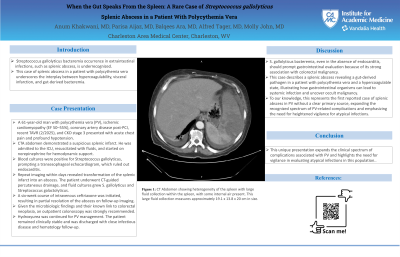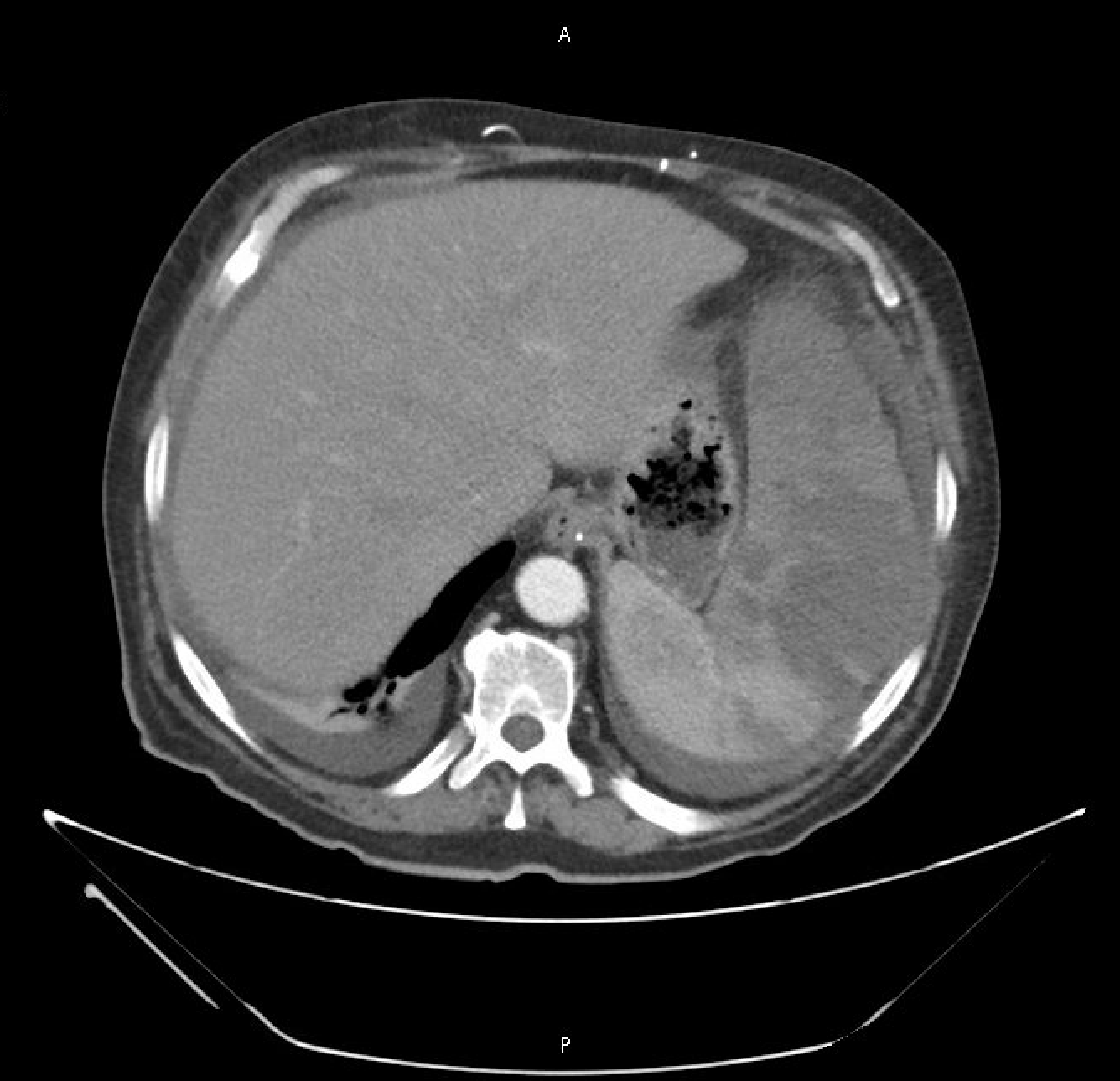Tuesday Poster Session
Category: Stomach and Spleen
P6350 - When the Gut Speaks From the Spleen: A Rare Case of Streptococcus gallolyticus Splenic Abscess in a Patient With Polycythemia Vera
Tuesday, October 28, 2025
10:30 AM - 4:00 PM PDT
Location: Exhibit Hall

Has Audio
- AK
Anum Khakwani, MD
Charleston Area Medical Center
Charleston, WV
Presenting Author(s)
Anum Khakwani, MD, Parisa Aijaz, MD, Balqees Ara, MD, Alfred Tager, MD, Molly John, MD
Charleston Area Medical Center, Charleston, WV
Introduction: Streptococcus gallolyticus bacteremia is classically associated with colorectal neoplasia, often leading to early gastroenterology involvement. However, its identification in rare extraintestinal infections, such as splenic abscess, is less recognized. We present a diagnostically challenging case of splenic abscess in a patient with polycythemia vera (PV), highlighting the intersection of hypercoagulability, visceral infarction, and gut-origin bacteremia.
Case Description/Methods: A 61-year-old man with polycythemia vera (PV), ischemic cardiomyopathy (EF 50–55%), CAD post-PCI, recent TAVR (2/2025), and CKD stage 3 presented with acute chest pain and profound hypotension. CTA abdomen revealed a suspicious splenic infarct. He was admitted to the ICU, resuscitated with fluids, and started on norepinephrine.
Blood cultures grew Streptococcus gallolyticus, prompting a transesophageal echocardiogram, which ruled out endocarditis. Repeat imaging within days showed transformation of the infarct into a splenic abscess. He underwent CT-guided percutaneous drainage. Fluid cultures yielded S. gallolyticus and Streptococcus alactolyticus.
The patient was started on a six-week course of intravenous ceftriaxone. Interval imaging showed partial resolution of the abscess. Given the microbiologic findings and their association with colonic neoplasia, an outpatient colonoscopy was strongly advised. Hydroxyurea was continued for PV. The patient remained clinically stable and was discharged with close infectious disease and hematology follow-up.
Discussion: S. gallolyticus bacteremia—even in the absence of endocarditis—warrants gastrointestinal evaluation due to its well-established association with colorectal malignancy. In this case, a splenic abscess revealed a gut-derived pathogen in a patient with an underlying hypercoagulable state. The presentation underscores the importance of recognizing how gastrointestinal organisms can drive systemic infection and signal the presence of occult malignancy. To our knowledge, this is the first reported case of a splenic abscess in a patient with polycythemia vera, occurring without a clearly defined primary source. This unique presentation expands the clinical spectrum of complications associated with PV and highlights the need for vigilance in evaluating atypical infections in this population.

Disclosures:
Anum Khakwani, MD, Parisa Aijaz, MD, Balqees Ara, MD, Alfred Tager, MD, Molly John, MD. P6350 - When the Gut Speaks From the Spleen: A Rare Case of <i>Streptococcus gallolyticus</i> Splenic Abscess in a Patient With Polycythemia Vera, ACG 2025 Annual Scientific Meeting Abstracts. Phoenix, AZ: American College of Gastroenterology.
Charleston Area Medical Center, Charleston, WV
Introduction: Streptococcus gallolyticus bacteremia is classically associated with colorectal neoplasia, often leading to early gastroenterology involvement. However, its identification in rare extraintestinal infections, such as splenic abscess, is less recognized. We present a diagnostically challenging case of splenic abscess in a patient with polycythemia vera (PV), highlighting the intersection of hypercoagulability, visceral infarction, and gut-origin bacteremia.
Case Description/Methods: A 61-year-old man with polycythemia vera (PV), ischemic cardiomyopathy (EF 50–55%), CAD post-PCI, recent TAVR (2/2025), and CKD stage 3 presented with acute chest pain and profound hypotension. CTA abdomen revealed a suspicious splenic infarct. He was admitted to the ICU, resuscitated with fluids, and started on norepinephrine.
Blood cultures grew Streptococcus gallolyticus, prompting a transesophageal echocardiogram, which ruled out endocarditis. Repeat imaging within days showed transformation of the infarct into a splenic abscess. He underwent CT-guided percutaneous drainage. Fluid cultures yielded S. gallolyticus and Streptococcus alactolyticus.
The patient was started on a six-week course of intravenous ceftriaxone. Interval imaging showed partial resolution of the abscess. Given the microbiologic findings and their association with colonic neoplasia, an outpatient colonoscopy was strongly advised. Hydroxyurea was continued for PV. The patient remained clinically stable and was discharged with close infectious disease and hematology follow-up.
Discussion: S. gallolyticus bacteremia—even in the absence of endocarditis—warrants gastrointestinal evaluation due to its well-established association with colorectal malignancy. In this case, a splenic abscess revealed a gut-derived pathogen in a patient with an underlying hypercoagulable state. The presentation underscores the importance of recognizing how gastrointestinal organisms can drive systemic infection and signal the presence of occult malignancy. To our knowledge, this is the first reported case of a splenic abscess in a patient with polycythemia vera, occurring without a clearly defined primary source. This unique presentation expands the clinical spectrum of complications associated with PV and highlights the need for vigilance in evaluating atypical infections in this population.

Figure: CT Abdomen showing heterogeneity of the spleen with large fluid collection within the spleen, with some internal air present. This large fluid collection measures approximately 19.1 x 13.8 x 20 cm in size.
Disclosures:
Anum Khakwani indicated no relevant financial relationships.
Parisa Aijaz indicated no relevant financial relationships.
Balqees Ara indicated no relevant financial relationships.
Alfred Tager indicated no relevant financial relationships.
Molly John indicated no relevant financial relationships.
Anum Khakwani, MD, Parisa Aijaz, MD, Balqees Ara, MD, Alfred Tager, MD, Molly John, MD. P6350 - When the Gut Speaks From the Spleen: A Rare Case of <i>Streptococcus gallolyticus</i> Splenic Abscess in a Patient With Polycythemia Vera, ACG 2025 Annual Scientific Meeting Abstracts. Phoenix, AZ: American College of Gastroenterology.
